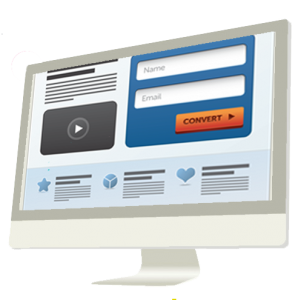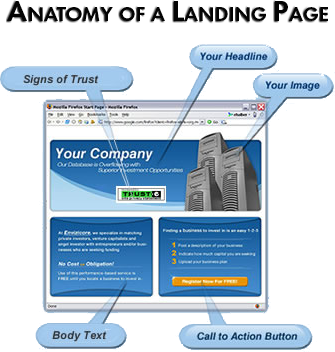10 Best Practices to Optimize Your Landing Page
 When prospects come to your website, do they know how to engage with you? Or do they feel like they’ve been dropped in the middle of Wal-Mart without a clue as to which aisle to visit or what sign to read because there’s so much information?
When prospects come to your website, do they know how to engage with you? Or do they feel like they’ve been dropped in the middle of Wal-Mart without a clue as to which aisle to visit or what sign to read because there’s so much information?
The issue is that you may not have a landing (or destination) page that is designed to convince visitors in just a few seconds to become a lead or a customer by providing you their information in return for an offer.
On average, over 70% of visitors to your site are new visitors, and a properly designed landing page will enable you to convert many of them to prospects.
So what’s a landing page?
A landing page is a destination on your site that is typically linked to from a pay-per-click (PPC) ad, from social media, from an email newsletter, from a blog post, or from a banner ad on the Web.
And on a good landing page, less is more – it should contain your logo, a main image, a description of your service or product, perhaps a testimonial, and a form related to an offer or call-to-action (CTA). The offer could be a free trial, a free white paper, a free e-book, a free audit, a free Webinar … something that is compelling enough for the visitor to provide you with their information in exchange for that offer.
If you are driving traffic to your website and it’s all winding up on your home page that may be the reason why you’re not converting them. A home page isn’t usually the best landing page! And if you do have a landing page and you’re finding it’s not effective, perhaps it just needs a good tune-up.
Here are 10 tips on how to optimize your landing pages:
- Build trust. Visitors should feel an atmosphere of trust where they can part with their information without feeling like they are risking their privacy. You can include testimonials, privacy statements, partners, and clients’ logos to reassure them.
- Stay focused. Decide on a single objective for each of your landing pages. Don’t cram too many messages onto the page that may distract your visitor. Be succinct, be clear.
- Be consistent. The title, the look-and-feel, and the content should be a continuation of the discussion you started where they first found you – in your PPC ad, your banner ad, your media campaign, or in a search engine (like Google).
- Send out a clear message. Keep the page’s content short and sweet. Don’t complicate things. State what might be the visitor’s problem, discuss your solution, and deliver the goods in a professional manner.
- Focus on that CTA. Your call-to-action is the most important part of your page as it tells your visitor what to do next after arriving on your site. What can you offer them in return for their personal information so you can market to them? A free trial account? A free report? A discount? A white paper? Depending on your business niche, come up with something that is worthwhile to your prospect.
- Present a simple form to fill out. Every landing page needs a form to convert your visitor to a lead and it should be located in a spot that’s very visible. The Golden Rule is, shorter forms convert better. We recommend not more than five fields and not all need to be mandatory. Remember that this is just the beginning of your dating process; there will be plenty of time to learn more about your prospect later on.
- Think branding. This may be the first time the visitor sees your brand. Include your logo and tag line as well as an image that relates to the offer.
- Drop the navigation. Most successful landing pages remove the navigation bar from the page. We are trying to keep the visitor focused on the message, the offer, and the form. Don’t give them an opportunity to navigate to somewhere else.
- Say “thank you.” After your prospect submits the form with their information, they ought to see a “thank you” page. Make it personal. Thank them for their time, and talk about next steps. And send them an automated, personalized email with content similar to the “thank you” page but with links to your site, your blog, and maybe an additional offer.
- Keep an eye on your competitors. Learn from them. Check out their landing pages and offers. Your visitors may be visiting their landing pages as well, either before or after yours. Make sure yours is better!
If you need help designing and optimizing your landing pages check out our landing page process and platform as well as a few examples.












